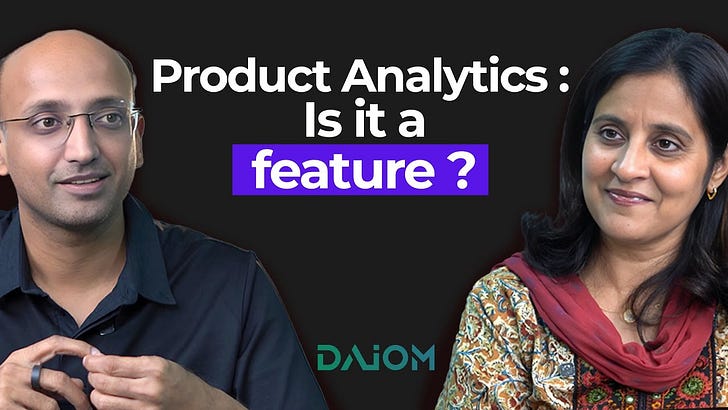Product Analytics : Is it a skill or a career?
Product Analytics is one of the core areas of interest for PMs. So lets deep dive...
In my latest episode of Product Talk with Malthi, I sat with Saurabh Agarwal who is Ex-SVP of Marketing at Lenskart and now is the founder of DAiOM, and helps brands grow profitable Omni channel growth with Tech , Ai and Growth Marketing.
In this discussion we deep dived into the world of Product Analytics – How is it different from Marketing Analytics. We spoke about Omnichannel strategies and how it impacts customer journeys. Best part is we spoke about a lot of examples – do catch them in the episode. In the end, Saurabh also shares some key insights as PMs should build their brands. A key insight is how product analytics are a key feature in many products.
As a special gesture, Saurabh is also hosting a Master Class on Omnichannel Strategies. Do scroll down to sign up for this session. Here are key insights from the discussion.
Catch up the full episode here:
Here are the highlights of the discussion
The Evolution of Product Analytics: A Skill or a Career?
Traditionally, product analytics was considered a specialized career requiring deep expertise in data analysis, metrics tracking, and user behavior modeling.
However, with advancements in AI, cloud computing, and self-service analytics tools like Amplitude and Mixpanel, data analysis has become significantly more accessible.
Many product managers now use analytics tools as part of their day-to-day work, making it a skill rather than a dedicated career.
The shift is similar to how Excel proficiency was once a career differentiator but later became a fundamental skill expected in most corporate jobs.
🤖 AI’s Disruptive Role in Product Management and Development
AI is reshaping two key areas:
Marketing Content Generation: AI is being used to automate text, images, and even video content, reducing manual effort in branding and advertising.
Product Development: AI-driven tools can now assist with coding, UX design, and even full product prototyping, reducing development time.
He shared an example of winning an AI hackathon by building a fully functional weather app in 10 minutes without prior coding knowledge.
The challenge for product teams is to go beyond just using AI for small efficiency gains and rethink entire workflows.
AI adoption requires balancing speed and cost-effectiveness, as AI models come with high operational expenses.
📈 Measuring Product Success: More Features ≠ Better Product
Many product managers measure success based on feature releases, leading to a “feature factory” mindset where adding new features is prioritized over improving user experience.
Apple’s iPhone, with fewer features than some competitors, is a prime example of a product that succeeds due to superior UX and customer loyalty.
Startups and traditional businesses need to redefine their KPIs, focusing on usability, adoption, and engagement instead of just backlog completion.
🏥 Healthcare & Wearables: How Product Analytics is Transforming Industries
Wearable devices like smartwatches and fitness rings generate vast amounts of health data, enabling companies to improve user experiences.
Interestingly, research suggests that one of the most-used smartwatch features is changing watch faces, rather than health-tracking metrics like step counts or heart rate.
This underscores the importance of understanding real user behavior, rather than assuming the features designed for a product are the ones that will be used most.
Analytics allows product managers to refine offerings based on data, ensuring better personalization and user retention.
🛍️ Omni-Channel Retail: CaratLane’s Success Story
Omni-channel retail ensures a seamless shopping experience across digital and physical stores.
CaratLane, a jewellery brand, has successfully merged online browsing with in-store experiences by:
Allowing customers to check local store inventory online.
Enabling reservations for specific designs before visiting a store.
Offering home try-on services for jewellery purchases.
The complexity of merging digital and physical shopping requires advanced product management kills, highlighting how product analytics plays a critical role in optimizing user journeys.
📢 The Power of Personal Branding: LinkedIn as the New Résumé
Traditional job-seeking methods (like applying through job portals) are becoming obsolete for mid-to-senior-level professionals.
LinkedIn has emerged as the dominant platform for professional networking and job discovery.
A compelling LinkedIn profile should go beyond listing experience—it should demonstrate thought leadership through posts, interactions, and personal insights.
🔍 Understanding Product vs. Marketing Analytics
Product analytics and marketing analytics both fall under digital analytics, but they serve different functions:
Marketing analytics focuses on customer acquisition, ad performance, and engagement metrics.
Product analytics ensures smooth user journeys, tracking conversion rates, drop-off points, and feature adoption.
He shared an anecdote where an e-commerce company miscalculated inventory demand based on product sales alone—failing to account for related product stock-outs.
This example highlights the importance of comprehensive data analysis, rather than making decisions based on isolated metrics.
Sign up for the masterclass here:
If you would like to be part of this podcast, then please fill this form https://forms.gle/wGMz53zMW9o6WQcy8



